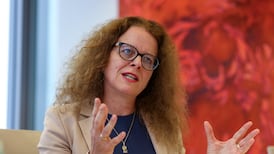A piece of marine technology designed by NUI Galway scientists has been deployed in the saltiest part of the world's oceans this month as part of research on the impact of climate change.
The Air-Sea Interaction Profiler (ASIP) has been gathering key information for the international expedition on board the Spanish research vessel, Sarmiento de Gamboa in a north Atlantic area about 1,000km west of the Cape Verde islands.
The torpedo-shaped device is unique, and was built by the NUIG researchers led by Dr Brian Ward to measure the salinity, temperature and turbulence of the upper 10 metres of the ocean.
Salinity of the upper ocean is regarded as a much more reliable indicator of the water cycle than any land-based measurement.
Evolution of the water cycle in response to global warming is in turn regarded as one of the most significant climate change issues.
“Trying to connect the dots” is how Dr Ward describes the study, which involves Irish, Spanish and US collaboration. The international project is known as SPURS- as in, salinity processes in the upper ocean regional study.
“Everything that gets exchanged between the ocean and atmosphere, such as water, must cross the air-sea interface,” Dr Ward explains.
“The ocean contains most of the world’s water and provides most of the evaporation, while also experiencing most of the precipitation,” he explains.
“In focusing on this area, we are trying to better understand how small scale turbulence is responsible for the air-sea exchange of freshwater.”
Such “small scale processes” can affect large-scale patterns over the north Atlantic, he explains, and the consequent weather extremes, from drought to heavy rainfall, have a very tangible and immediate effect on societies.
The team, which involves two of Dr Ward’s PhD students, Graig Sutherland and Anneke ten Doeschate, travelled on the Spanish research vessel to the north Atlantic’s “salinity maximum” for the experiments, leaving the Canary Islands in mid March and steaming west of the Azores.
The initial part of their "ocean field campaign" involved towing their instrument behind the ship. A US ship also worked in the area, with collaboration from scientists with the Woods Hole Oceanographic Institution.
The US scientists compared the data they collected via autonomous gliders fitted with micro-sensors to the information collected by the NUIG profiler.
Intermingled
"We found quite a lot of freshwater intermingled with background salty water, but it is moving around quite a bit due to ocean currents," Dr Ward said. "We need to now how much of that freshwater is being exchanged."
When Dr Ward began his work on upper ocean measurement, he found that there were no suitable instruments available. “So we built our own,” he says.
His research group is based in NUIG’s AirSea Laboratory, which is affiliated to the university’s Ryan Institute.
The laboratory has also been involved in studying how carbon dioxide, a major greenhouse gas, is transported between air and sea.
The ocean and atmosphere are “coupled” and “need to be studied in unison”, Dr Ward explains.












